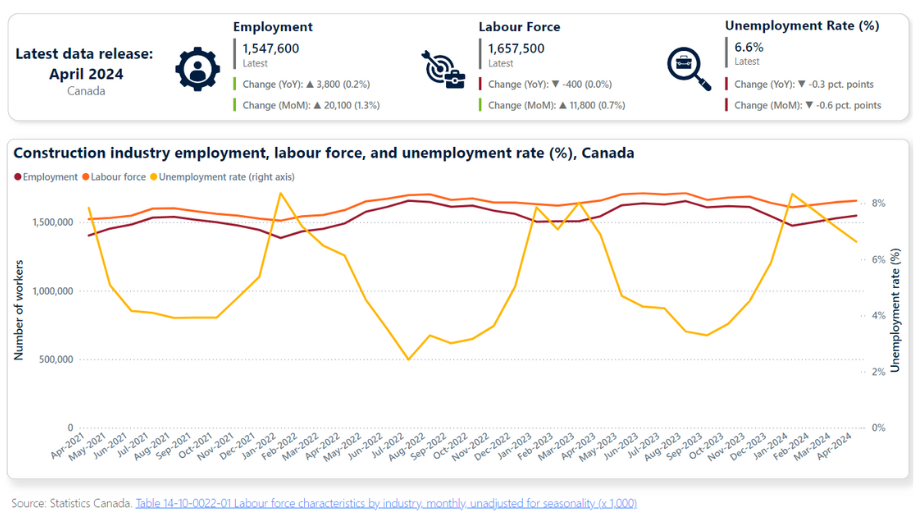Employment in Canada’s construction industry was mostly unchanged in April
Employment in Canada’s construction industry reported a slight increase in April, as six out of ten provinces reported employment gains. Meanwhile, the labour force – those workers employed or searching for employment – was mostly unchanged.
The latest data from Statistics Canada’s Labour Force Survey (LFS), from April 2024, finds that construction employment increased modestly by 3,800 (+0.3%) workers over the past 12 months to account for 1,547,600 workers Canada-wide. Meanwhile, the labour force remained mostly stable at 1,657,500 workers. As a result, the industry’s unemployment rate receded from 6.9% in April 2023 to 6.6% in April 2024.

The change in employment recorded in the construction industry followed similar trends to the national, all-industry employment growth of 0.4%. Nationally, the all-industry unemployment rate remained steady at 6.1% with rising employment in part-time work.
Six out of the ten provinces in Canada reported year-over-year growth in construction employment, with New Brunswick (+7,200, +27.1%) and Prince Edward Island (+1,100, +16.7%) leading the charge. Alberta (+15,200, +6.7%) and Quebec (+13,800, +4.6%) also saw sizeable increases in employment.
Ontario, meanwhile, reported the largest decline in construction employment with a decline of 25,300 workers (-4.3%). Declines were also significant in British Columbia (-9,400, -3.8%) with continued declines in employment among women and workers in the core working age (25 to 54 years old) likely stemming from winding down of major capital projects.
Construction employment among women continued to increase in April, with very strong gains recorded in Quebec (+10,000, +26.3%) which has seen employment among women increase more than 10% each month in 2024. Growth in employment among women was also strong in Alberta (+6,300, +17.4%).
Employment among women saw especially strong growth for young women aged 15 to 24 years old (+23%), with similar increases to the labour force. Employment for women in the core working age (25 to 54 years old), however, declined for the first time since December 2022.
Year-to-date (January through April), construction employment, labour force, and unemployment rates are mostly in line with their levels through the same period in 2023. Differences do arise at the provincial level, however.
Most noticeable is New Brunswick’s construction industry, which is posting year-to-date employment of 32,100 workers, or 25% above where the industry was through this period last year. As a result, the province’s construction unemployment rate has dipped below 14% compared to 16.8% last year.
Saskatchewan’s construction employment is down 5.9%, year-to-date, while the province’s labour force has neither increased nor decreased. This has caused the province’s unemployment rate to nearly double, from an average of 6.9% between January through April in 2023 to an average of 12.4% this year-to-date.
Year-to-date, construction unemployment rates are above their levels through the same period last year in British Columbia, Alberta, Saskatchewan, and Manitoba. From Ontario east, unemployment rates are below their levels last year.


Construction Key Indicators
